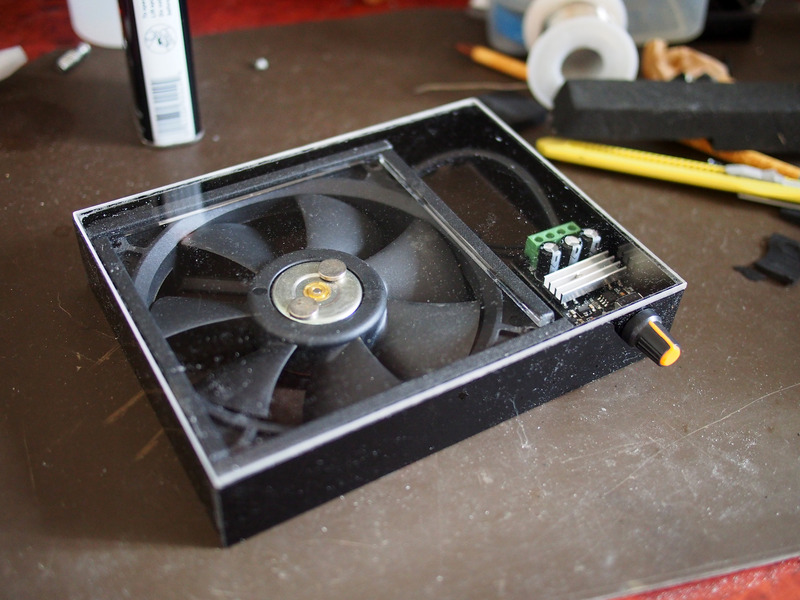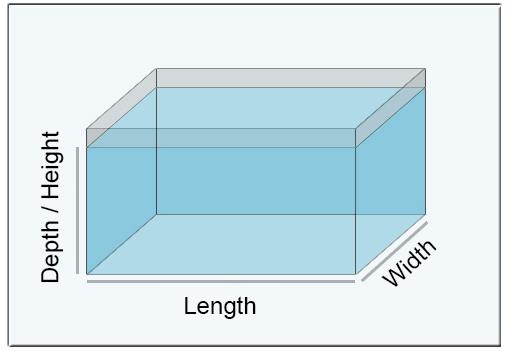-
Posts
2,331 -
Joined
-
Last visited
-
Days Won
119
Content Type
Profiles
Forums
Gallery
Everything posted by SubzeroLT
-
Sad to hear about the AEFW issue. Understand the pain & trouble you need to go through. On the bright side, good to see the gem tang doing well. Do share more pics.
-
Since installing the Ecotech Versa peristaltic pump last month, it was possible to better control the dosing rate & time to dose. And hence gave me the motivation to improve the kalk stirrer. Decided to re-do the stirrer box with better water proofing & cable management. The drawing here shows the feature to hold the speed controller PCB in place. Using a good quality PC fan (uses ball bearings). A PWM speed controller. And a couple of magnets. The top & bottom halves were printed with ABS material. Total time about 32 hours (top & bottom) halves. View of the kalk set up. Programmed to dose 2L from 12am to 12pm. And 200cc from 12pm to 12am. In this way, the bulk of the kalk is added during night time where pH is lowest.
-
Its frustrating when you need to take a coral out to cut. The stag got stung by another coral & the flesh started to recede (and spread). Had to take the frag out to trim. Re-doing the kalk stirrer since i'm now able to print a nicer housing. The total print time of top & bottom is about 32 hours Will share more once its done. This is the kalk stirrer made in 2016.
-
Thanks. For clean up crew that do work, a couple of snail will be useful (eg. astreas, trochus and possibly cowries). Cleaner shrimps can get to tight places. Red tip hermit crabs are safe to have in a mixed reef. Abalones are fast movers & great for the glass. I would avoid nesaurus snails as I've seen mine penetrate LPS to get to prawn meat (badly damaging the LPS in the process). Same goes with larger hermit crabs (eg blue leg hermit crabs). I also avoid sand sifting star fish as they are known to eat a ton of pods (which i'd rather the mandarin dragonets eat). Sand bed? Personally i would always have sand bed for a display tank. Looks more natural. Using aragonite sand also helps with tank stability (also mentioned on BRSTV).
-
Facebook message Reef Depot to get support on next steps.
-
Some recent shots : Porcelain crab on a rock flower anemone Superman blasto Forest fire digi Got this from Larry about 3.5yrs back Think the hammer corals got used to the crazy high flow just inches away from the wavemaker.
-
For the amount of sand to use, you can use online sand bed calculator resource. There are several available Here is an example : https://www.aqua-calc.com/calculate/gravel-rectangular-solid/substance/caribsea-coma-and-blank-marine-coma-and-blank-aragonite-coma-and-blank-seaflor-blank-special-blank-grade-blank-reef-blank-sand I find the Caribsea seaflor special grade reef sand to be a good sand. Grains are a little bigger which won't fly around so easily in strong water flow. Note it is dry sand which makes it a lot cheaper than live sand. But it does not really matter since you will be cycling the tank anyway. As soggycookies suggested, this is a good time to start cycling your bio media. Can place in a large container (eg ikea tub or large pail) and water pump. Then transfer the cycled bio media into your new tank to speed up the cycling process. Do share more pics along the way.
-
I've measured PAR on these lights before. Light is very focused with hot spots within a small area. IMO, not useful for corals at all. OK for growing macroalgae but note it has hotspots as well. There are better light options out there. The key is good light spread.
-
This is a simple adapter for the Skimz calcium reactor. #supportlocal I found that topping up the calcium reactor to be quite a trouble some process. Often getting bits of rocks around the O-ring, leading to improper seal & leaks. A funnel is ideal but its hard to find one that fits the 40mm fill hole size. Hence i printed this adapter for this wide mouth funnel (common used for pickling jars).
-
Agree. 3D printing brings new capabilities. And drafting the design is part of the fun.
-
3D printing is getting more popular in the past years. And there are quite a few reefers here who have 3D printers at home. Starting a thread to share some mini projects. My full tank project can be seen here : http://www.sgreefclub.com/forum/topic/142862-my-slice-of-nature-part-3/ Comments, feedback & new ideas are welcome. Kicking off with a reactor adapter for Nyos skimmer. Using this with biopellet reactor will ensure all the slime & bacteria from the biopellet reactor goes directly to the skimmer instead of going to the display tank where there may be a risk of causing cyano. Assembling it onto the Nyos skimmer inlet
-
Very nice What camera are you using for the recent photos?
-
I'm using a Skimz CM152 calcium reactor. An affordable & reliable model. #supportlocal There are many methods to tune the CR. My process parameters are : pH ~ 6.52 CO2 timing : 24hrs Effluent flow rate : 140cc/min Bubble count tuned to meet the above Media : Grotech Rowalith + ~30% Grotech Magnesium Pro Target parameters : Ca: 400, Mg : 1400, KH : 8.3 As with most CR media brands (Grotech Rowalith, Caribsea ARM, TLF Reborn), it provides mostly Ca, KH only. In order to supplement magnesium, one should add some Magnesium media. Popular brands are Grotech Magnesium Pro & TLF ReMag. Suggest to start with 10% Mg media first. If its not able to maintain Mg levels with respect to Ca, KH, then just add more Mg media. For my system, the sweet spot is around 20-30% Mg media. Here is a quick video on prepping for the top up :
-
Bigger is always better. In particular, width is important. 2.5' enables a much better rock scape than 2'. So i'd suggest 75cm For depth, 61cm is about right. Deeper tanks are nice but it makes maintenance harder. Its important to be able to reach the back of your tank to retrieve things easily. I had a 3ft tank running when i upgraded to this 5ft tank. And just simply transferred over (refer to my earlier threads "My Slice of Nature" & "My Slice of Nature Part 2). No major issues during the transfer as they were added slowly. Some corals did bleach a little. Possibly because the new tank has much cleaner water (low nitrate/phosphate) and high power lights. That was easily resolved by lowering the light intensity temporarily. Key advise 1) Join a good forum (like this one) or chat group. Read up. Make educated decisions. 2) Use good reliable equipment. Don't get cheap products & keep wasting money upgrading. 3) For livestock, choose compatible fish/coral. Add fish in the correct order. 4) For corals, MUST use coral dips. Many brands out there. TLF Revive is good. CoralRX is another popular brand. You can make DIY blends of coral dips but suggest to stick with store bought ones for a start. Its not expensive. Coral dips can kill pests that are exposed to the dip for sufficient period of time. Hence eggs or worms/crabs hiding in crevices may still survive. You can reduce the risk by cutting away the original rock or to quarantine the coral in a separate tank.
-
-
Some pics from today Octo Another octo Fiji pipe organ Encrusting Bali Slimer SSC SSC in whiter light Pink stylo Valida Spotted mandarin getting fat Max-mini anemone. Not so mini actually (about palm size)
-
Salt water prep process before water change :
-
A random pic taken with my mobile phone during the past week - Starry Blenny My regular dosing regime : Nyos Active Elements, Strontium, Iodine (2-3 times a week). And Nyos Bio Booster (daily) Time to empty the skimmate pail (connected to skimmer). This is about 3 weeks of stuff
-
You don't really require barb fitting. Suggest to get some silicone hose & connect the 2 pipes like this. Cable tie is optional as the silicone hose to pipe fitting is already quite tight.
-
Cleaned the pump a couple of days earlier. 1 year of dirt Stuff a piece of filter wool to wash the insides without the need to disassemble the clips. No rust on screws (as expected) 3 Just a general clean up of simple scrubbing & inspection. I don't soak pump parts in vinegar to minimize risk of acid damage. Proceeded to calibrate the pump. I attached a long flexible hose to the outlet pipe to monitor the water flow. Now all the pumps go into proper flow rates when feed mode is triggered -> no siphon effect for food to flow into the sump.
-
The next 2 posts is all about cleaning up. Cleaned the skimmer last night. Last wash was probably 1 year or maybe even 2 years ago. Skimmer body : An old credit card, filter wool + dishwashing liquid works well. For the features here, I used a small bit of filter wool + 3D plastic filament to push it through. A toothpick or paper clip will work just as well. Titanium screws in good condition. No rust (as expected) Done Up & running in less than an hour. The next morning.
-
Look forward to an update on your setup
-
Pics taken during day time today. Some pieces coloring up better with the Hydra64 in place. Orange Pavona from Seasonal Aquarium 2yrs back Leptastrea frag from a fellow reefer Below Walt Disney was from Reefing Reality. Thanks Jonathan for helping pick a nice piece. Frag from Lorenzo Croc Island Scoly. Sprouting a 4th head behind. Blastomussa merletti from Ah Beng Candy Cane from Ah Beng (2014)
-
Dosing Kalk 24/7. Different rates along the day
-
Installed the Versa this weekend. Well built continuous use peristaltic pump. And highly controllable with the Ecotech Mobius app. Comes with attachments to fit soft hoses. Calibration was quite simple. You can actually calibrate to the exact amount you want to dose (even large volumes) which makes it very accurate. In my case, i'm using it for Kalkwasser dosing. So its set to dose 1.5L of Kalk when lights are off (12am - 11am) And 500ml of kalk when lights are on (11am - 12am). Versa in action. Drawing water from ATO -> Kalk Reactor -> Tank. Slow drip at v controlled rate.


.thumb.jpg.57c2e34da3fe90fcdb8e11c6a93f46a9.jpg)
.thumb.jpg.d42380e2e5b333ad46e95de86768b38e.jpg)
.thumb.jpg.083487fd21f8f7dc6f10e925063110ea.jpg)
.thumb.jpg.6a7305cb010de95492763fdfd6d86d90.jpg)


.thumb.jpg.c700b096d15db530c05f3af50bb21659.jpg)
.thumb.jpg.5a58b6239163a4584bedf2f8c9e33c1a.jpg)
.jpg.147798177154d226e39a7b0a5fc480dd.jpg)
.jpg.60b7d3a6064615c486674446b5bd7534.jpg)
.jpg.f1dc481ad374299a41281059f6948314.jpg)
.jpg.0c779c38c043c45d36ff39e8522d4d64.jpg)
.jpg.6d0b2cd08e899197f48b43e72d7f2fef.jpg)
.thumb.jpg.89f7d56cc5463e68224c86c8e2f70ed1.jpg)
.thumb.jpg.94328530cef2670738f60fa8d01ffdf5.jpg)
.thumb.jpg.3409bddbf3941c96de2bc107cf1b7388.jpg)


.jpg.425e38bd1fc3487d55331e1fe332ca7c.jpg)
.jpg.1e0a044d7adedd486b8073999e546e3a.jpg)
.thumb.jpg.7397bdd21b2b2509a3c4f17474d8c9a3.jpg)
.jpg.cf6461d998eca4cb89613a0353d7cc3c.jpg)
.jpg.1eb08fffa00f41706b3105a80f890a90.jpg)
.jpg.0c1325fbe7416c9964d0261be79726e6.jpg)
.jpg.ce0a266b9a1aea8503d3091e8cd22f2c.jpg)
.jpg.88f6ed79080000f465d6a2d12edb19a4.jpg)
.jpg.cf765ec8265b315e77d00cc1e4dd6667.jpg)
.jpg.77fc1feb2368818c72cd157dca807bee.jpg)
.jpg.b45aa191531d19d417095ceacb3a8b10.jpg)
.jpg.17aa85f18a7442895eafebc49cffa3bf.jpg)
.jpg.31d0278cd4d59187c0bad131365e7226.jpg)
.jpg.bbd34e705eafc4cb1a8c5a423db30669.jpg)
.jpg.5eefa38a6f904903bc867ff2ed404afa.jpg)
.jpg.616f8387e89b0d5e68037a4c8a334431.jpg)
.jpg.50b6237e0f042aa1e126eeaf9659360d.jpg)
.jpg.48dde883b68bff7d7e48411e81a68a7c.jpg)
.thumb.jpg.16bec514d092e01e13e183ea456584ee.jpg)
.thumb.jpg.d1c93bc42f21dfb4e350bffe52fe06db.jpg)
.thumb.jpg.84b2b4d142eabb70e4d28041d765bfdf.jpg)
.thumb.jpg.a6f813bea33950aef7ba0cda37fc707a.jpg)
.thumb.jpg.5359b7e03a5497ff1ca8f8fd05dc9dda.jpg)
.thumb.jpg.fef062560426ccff531c2bc674904adc.jpg)
.thumb.jpg.d4725bb309b515c9deeb389cd395d081.jpg)
.thumb.jpg.760a14541196c42140d9906fc04fef76.jpg)
.thumb.jpg.e5739f01beb8b16d3912130b16f7b494.jpg)
.thumb.jpg.e68d2eb512324ed7ac3e916e7bc01337.jpg)
.thumb.jpg.9e96c6ba776d11f1f8b2cdeb9a9dd9cf.jpg)
.thumb.jpg.5c322f2f3641ea8191bfe378d5bd6f7a.jpg)
.thumb.jpg.d5de14330e2a7977d33ace0b5f32a516.jpg)
.thumb.jpg.9a3591ded078f621522e04e06cde5dff.jpg)
.thumb.jpg.7250d8d0d82558aa473226be55233cad.jpg)
.thumb.jpg.627a6b56cbd520dea1fd86e0770b5ac7.jpg)
.thumb.jpg.70ecfdb34ebe581ceb532c7d2961171f.jpg)
.thumb.jpg.4ae0e7a98d0ce63a368acb1b6201b8f2.jpg)
.thumb.jpg.a357e5191743b251c52c3143e9ee6e19.jpg)
.thumb.jpg.6983ec659d1542806995252cec64ca20.jpg)
.thumb.png.7979e14a074708d77172c0411cf66f28.png)
.thumb.png.2b0b62a814e24ab7deea27739d203ea4.png)
.thumb.jpg.ce4e12a60b241a1bd336135b06e689f4.jpg)
.thumb.jpg.e02e6ae2d96a033b9b1eaeb521ac6f14.jpg)
.thumb.jpg.aef69450fd112490c8d97fcd466a885e.jpg)
.thumb.png.bd0c99a0ca1f508d6a9796629ab4df86.png)